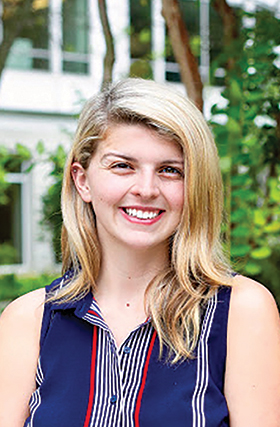Solving for Inclusivity in Physics
Fall
2020
Feature
Solving for Inclusivity in Physics
Molly McDonough, 2019–20 Associate Zone Councilor Representative, SPS National Council Executive Committee
 The AIP National Task Force to Elevate African American Representation in Undergraduate Physics & Astronomy (TEAM-UP) recently published its study of the reasons behind and recommendations to address the persistent underrepresentation of African American students in our field. As the honor society of the physics field, Sigma Pi Sigma has a unique obligation to not only support the efforts of the TEAM-UP report but also to work within our community to implement its recommendations to combat the related issues that have plagued our community. While some conclusions in the TEAM-UP report are not new, the collection as a whole serves as a beacon to guide us to a better place. The student voices from the report serve as an honest reflection of many of the issues that stop students from moving forward with their education, whether for advanced or undergraduate study.
The AIP National Task Force to Elevate African American Representation in Undergraduate Physics & Astronomy (TEAM-UP) recently published its study of the reasons behind and recommendations to address the persistent underrepresentation of African American students in our field. As the honor society of the physics field, Sigma Pi Sigma has a unique obligation to not only support the efforts of the TEAM-UP report but also to work within our community to implement its recommendations to combat the related issues that have plagued our community. While some conclusions in the TEAM-UP report are not new, the collection as a whole serves as a beacon to guide us to a better place. The student voices from the report serve as an honest reflection of many of the issues that stop students from moving forward with their education, whether for advanced or undergraduate study.
As Sigma Pi Sigma members, we all promised to not just encourage others to study physics but to strive to help them succeed. Fellowship takes many forms, and part of our promise includes making the recommendations of the TEAM-UP report work for students, faculty, and undergraduate departments. We are 76,000 physicists strong, and collectively we can serve future generations by ending the persistent underrepresentation of African American people in physics and astronomy.
“There was one teacher that really, honestly, I was going to give up on physics and she changed everything… She just kept checking in on me.” - Student comment during a TEAM-UP focus group session
While the physics and astronomy community acknowledges there is a need for a significant increase in diversity and inclusion of people of all gender identities, races, ethnicities, sexual identities, socioeconomic statuses, and ability statuses, the number of bachelor’s degrees awarded to African American students in physics and astronomy remains appallingly low. The total number of physics undergraduate degrees earned in the US has more than doubled in the last two decades1. While the number of African American students earning an undergraduate physics degree has increased over this period, the percentage of African American physics grads has remained well below the 13% of the US population composed of African American people.1,2
Physics and astronomy (and science as a whole) is a team sport. Science works best and leads to more innovation when groups of people with differing perspectives come together and work towards a common goal. A study of over 2.5 million scientific papers conducted by Freeman and Huang at Harvard University found that while authors of similar ethnicities (as suggested by their last names) published together more frequently, publications written by authors with diverse ethnic backgrounds were more likely to be published in higher-impact journals and receive more citations.3 This serves as empirical evidence that diversity and inclusion in physics and astronomy is not just important as a social cause but also as a scientific one. Including broader perspectives and people from diverse backgrounds is critical to innovation in science and speaks directly to the mission of Sigma Pi Sigma.
In 21st-century physics and astronomy, there is no place for institutionalized racism. As the primary student organization for students of physics and astronomy and an honor society that strives to support and encourage interest in physics at all levels, we must take it upon ourselves to support and educate our chapters, students, faculty, and departments on the value of inclusivity and diversity in physics and astronomy. Sigma Pi Sigma, and in turn each of us, would do well to use the TEAM-UP report as a tool to help us step up and solve for inclusion in physics.
References:
1. AIP TEAM-UP report: https://www.aip.org/diversity-initiatives/team-up-task-force.
2. https://www.census.gov/quickfacts/fact/table/US/PST045219.
3. Richard B. Freeman and Wei Huang, “Collaborating with People Like Me: Ethnic Coauthorship within the United States,” J. Labor Econ. 33, no. S1 (2014); “US High-Skilled Immigration in the Global Economy,” J. Labor Econ. 33, no. S1, Part 2 (July 2015): pp. S289–S318, DOI: 10.1086/678973, https://www.jstor.org/stable/10.1086/678973.
